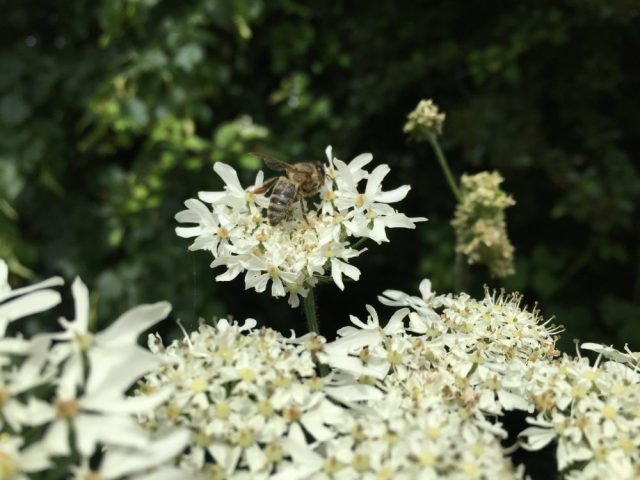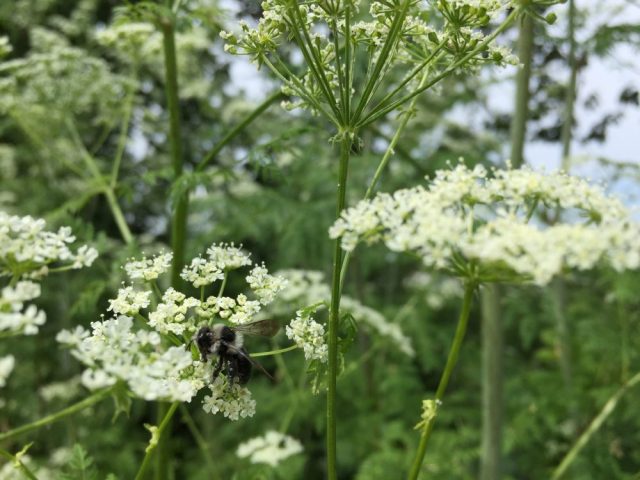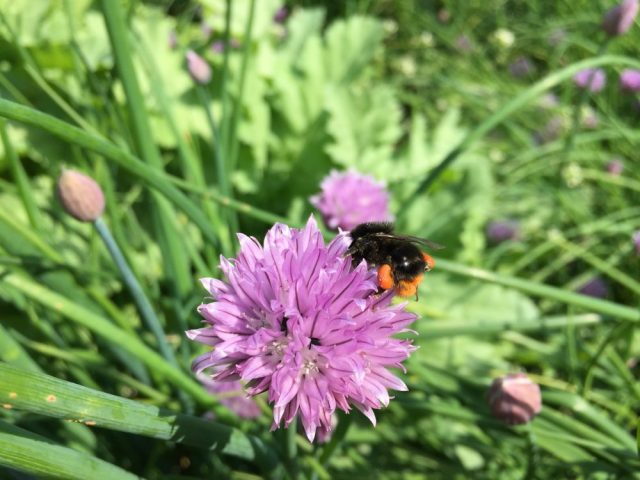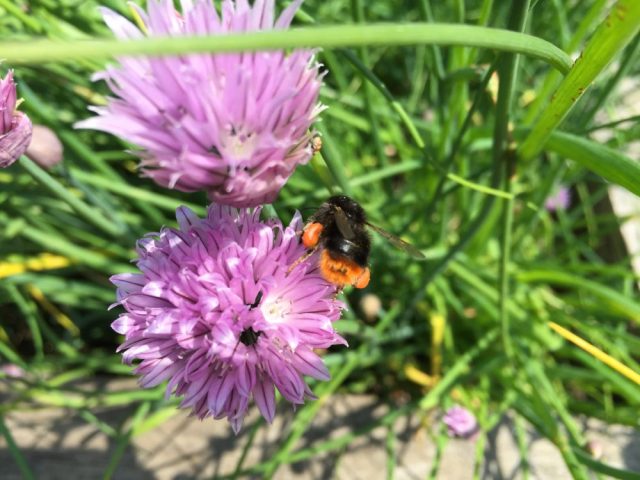The flowers have moved on since my last post in May. Some are still with us – white dead-nettle, gorse, dandelions, green alkanet; while others, like horse chestnut and daffodils, have faded. London bees now have a new mix of wild and garden flowers to choose from. Here’s what I’ve been finding them on in local parks.
Two pink comfrey bushes in Elthorne park rough were humming with buff-tailed bumblebees. There are also white varieties of comfrey. It is listed in Prof. Dave Goulson’s list of ‘The best garden flowers for bees‘ – he says it has a “Very long flowering period, from May to August, and one of the very best plants for bees. Visited by long and short-tongued species, the latter often robbing from holes bitten in the tops of the flowers.”
You can see some lovely photos of a male early bumblebee (Bombus pratorum) stealing from comfrey on a post by TrogTrogBlog: Nectar robbers. Honey bees also benefit from the holes bitten by short-tongued bumblebees.
In the fields of Elthorne rough, masses of graceful cow parsley and hogweed grow tall. A few honey bees and bumbles can be found on their delicate little white flowers, along with shiny metallic green beetles. I recommend the post ‘Hogweed days‘ on the Everyday Nature Trails blog to find out more about the pollinators that visit hogweed.
I was particularly pleased to find an Ashy-Mining bee, with its pretty grey and black stripes. Judging by the BWARS description, this is a female, which have “two broad ashy- grey hairbands across the thorax.”
Along the edges of the paths are blackberry brambles, which are popular with both bumbles and honey bees. In his Guide to Bees & Honey, (2010, p.221) Ted Hooper says blackberry is “Well worked by bees even at fairly low temperatures, supplying both nectar and pollen in quantity. Honey of good flavour, medium amber, tending to granulate with a care-grained texture. Pollen load pale brownish grey.”
In the fancier, more formal Lammas park, I found carder, bumble and honey bees on these purple irises and a orange balled flower. Not knowing what the orange balls were, I looked online to find that the plant is called… the orange ball tree (Buddleja globosa). It originally comes from south America.
And in the kitchen gardens of Walpole park are chives, which were being visited by this Red-tailed Bumblebee (Bombus lapidaries). The pollen co-ordinates well with its bottom!
Coming soon: white clover, thistles, knapweed, rosebay willow herb, himalayan balsam and ragwort.
And below is an advert for the powers of royal jelly – look how chubby those cheeks are now 🙂














This time of year it is nice to just stand under the trees in my street and listen to the hum of the bees working them.
LikeLike
I love doing that too 🙂
LikeLike
Lovely photos of all the flowers (and Thomas!) . I’ve taken a cutting of the orange ball tree from my neighbour’s plant (for the bees). Sadly there are no orange balls on it yet! The bees have found my comfrey, though, which they love.
LikeLike
Thanks Wendy. Good luck with your orange ball tree, it is a funky plant.
LikeLike
Love these photos! Comfreys are interesting…we don’t have any native ones, I don’t think, although people plant white comfreys. That family, Boraginaceae, is also represented by our Virginia Bluebells (Mertensia). Also, love the Buddleja, weird plants in that genus! PS Published a paper on Himalayan Balsam a couple of years ago
LikeLike
Will have some photos of the balsam later – what was your paper on it about?
LikeLike
Because it is invasive, I was using it to demonstrate the impacts an invasive plant can have on pollinator community structure! It’s a supergeneralist, so it tends to attract new species to the plant community.
LikeLiked by 1 person
I love the Ashy mining bee! There are a lot of flowers around in your post which makes me wonder about the famous “June gap”. There seem lots of flowers here too but the beekeepers are bemoaning the fact that the Acacias are finished (a lot of the flowers destroyed by rain this year) and the Chestnut trees not flowering for a few weeks yet. Thomas is the picture of contentment. Amelia
LikeLike
The “June gap” is more of a countryside phenomenon once the hawthorn hedges and oil seed rape has finished flowering. We have a wider variety of exotic flowers planted in London so it’s not so much of a problem. I love the Ashy mining bee too!
LikeLiked by 1 person
Ah, plumb tired out from all the excitement over the Ashy mining bee. Do they make bee suits in baby size?
LikeLike
They certainly make bee suits in little children size – maybe even toddler? 🙂
LikeLiked by 1 person
Good to see so many blooms available for the bees! I had to look up alkanet. Interesting stuff and a dye plant, to boot. Your boy is still adorable 😀
LikeLike
Thanks Mark. Alkanet is not a showy plant but I like its little blue flowers. It grows in all the waste ground and wilder parts of parks round here.
LikeLiked by 1 person
In our garden there is no June Gap, in fact when the sun shines there are many bees. The comfrey is very popular with the Carder bees, raspberries (almost over) were very popular with early bumblebees (males particularly bright with yellow and orange) and honeybees, philadelphus attracting bumbles and some solitaries and the cotoneaster just haveing come in to flower and attracting bumbles and the odd wasp.
LikeLike
Lucky you having raspberries. Hope you get a good crop – they taste great with honey of course.
LikeLike
Royal jelly eh? Is this your attempt to turn Thomas into a queen bee? 😉 The orange ball tree is lovely. I ordered one for our garden this year, though it’s yet to arrive, it looks so cheerful 🙂 Lovely post and pics Emily!
LikeLike
Thomas will make a great queen bee, we just need to work on the wings 🙂 The bees in your garden will be happy to have the orange ball tree! It is a cheerful one indeed, the flowers are like little pom-poms.
LikeLiked by 1 person
We have lots of White Comfrey and Alkanet in our garden. The alkanet is enormously popular with honey bees. The comfrey probably more of a draw for the bumblebees. Love the Ashy Mining Bee!
LikeLike
The alkanet probably has easier nectar for the shorter-tongued honey bees to reach. i have also seen many more bumblebees on the comfrey.
LikeLike
Emily,That is a very interesting blog. Thank you for that. It is wonderful seeing all the pollinators on the variety of flowers. At the moment our several varieties of cotoneaster are buzzing with honeybees as well as bumbles. Amelia has planted so many flowering shrubs and flowers that I do wonder if the bees need to go far for their needs.
The little one looks so content and peaceful. I wish your family all the best. – Kourosh
LikeLike
Thanks Kourosh. Your garden is a truly wonderful place, I love reading your posts about its flowers and inhabitants.
LikeLike
Great pictures, thank you. We’ve had the Bumbles come out in force on our Lambs Ear which is flowering in our yard here in the US.
I’m not sure if you are feeding Thomas Royal Jelly or reading him Roald Dalh’s short story. Perhaps a bit of both?
LikeLike
I’ve heard Lambs Ear is a favourite with the Wool carder bee, as it uses hairs from the leaves to make its nest. I’d better not say more about Thomas’s diet in case someone calls social services 😉
LikeLiked by 1 person
Yes, we have one of your carder bees on our Ears – the European Carder Bee of course. I’m sure Thomas’ diet is more than fine. Enjoy.
LikeLike
There really should be a bee on every flower. It makes things right in the world. I agree, cute little rosy, chubby cheeks. All things right in the world.
LikeLiked by 1 person
Firstly, thank you for the link to my hogweed post! I loved the little mining bee and am always fascinated by which flowers different bee species are drawn to. Baby is growing beautifully – I love how short baby arms are!
LikeLike
You’re welcome, it’s a great post. Tom waves his little baby arms to say hello!
LikeLike